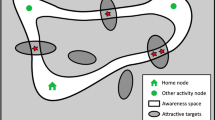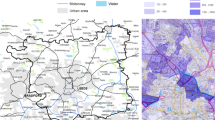Abstract
Crime is a complex phenomenon. To understand the commission of crime, researchers must map both the temporal and the spatial processes involved. The current research combines a temporal method of analysis, Behaviour Sequence Analysis, with geospatial mapping, to outline a new method of integrating temporal and spatial movements of criminals. To show how the new method can be applied, a burglary scenario was used, and the movements and behaviours of a criminal tracked around the property. Results showed that combining temporal and spatial analyses allows for a clearer account of the process of a crime scene. The current method has application to a large range of other crimes and terrorist movements, for instance between cities and movements within each city. Therefore, the current research provides the foundation framework for a novel method of spatio-temporal analyses of crime.




Similar content being viewed by others
Notes
Clearly, real-world data are seldom so ‘clean’; however, the current paper is meant to outline the methodological approach, therefore, more detailed data were preferable.
In other crimes this may be a point at which a suspect is more easily apprehended; or in evacuation scenarios, this could be finding where bottle-necks occur etc.
There were no systematic differences between those participants that were Forensic Psychology students, and those that were not. Therefore, the sample was analysed as a whole. An alternative approach could have been to create a set of ‘dummy’ data (as in Keatley and Clarke 2019); however, to provide a somewhat more realistic dataset based on verbal reports (akin to witness statements), we used participants.
A floor plan was given to provide some consistency to participants’ accounts of crime sequences (otherwise, any number of different properties could be envisioned, and while this would be possible to group and analyse, it was deemed overly complex for the present study). While the floor plan does reduce ecological validity, it does allow for a clearer map to emerge, to show how Behaviour Tracking works. Again, the current article is meant to showcase the Behaviour Tracking method, rather than provide an explanation of burglary, per se.
In computer-generated illustrations the two diagrams can be animated and overlaid. This allows investigators to see global-level movements (between rooms, Fig. 3), and nested Behaviours within each room (Fig. 4). This would be akin to criminals moving between cities or countries (global movements) and actions within each city (nested Behaviours).
This is likely a caveat of providing participants with an inventory of each room, a priori; they knew beforehand that the bathrooms provided no items worth stealing. Obviously, in actual crimes, most burglars do not have this foreknowledge. However, this is a limitation of the current data, not the current method. Similarly, real-world data will provide many more nuances and pathways in the dataset (e.g. dogs, people being home etc.). This makes the analyses more complex; but, the basic approach outlined here remains the same.
References
Arntfield, M. 2016. ’Money. Armed. Quietly’: A sociolinguistic analysis of criminogenic prose in institutional holdup notes. Semiotica 208 (1): 237–258.
Arntfield, M. 2017. Mad city: The true story of the campus murders that America forgot. New York: Little A Books.
Bakeman, R., and J.M. Gottman. 1986. Observing behavior: An introduction to sequential analysis. Cambridge: Cambridge University. https://doi.org/10.1017/CBO9780511527685.
Bakeman, R., and V. Quera. 2011. Sequential analysis and observational methods for the behavioral sciences. Cambridge: Cambridge University Press. https://doi.org/10.1017/cbo9781139017343.
Beauregard, E., M. DeLisi, and A. Hewitt. 2017. Sexual Murderers: Sex offender, murderer, or both? Sexual Abuse 30: 932–950.
Caneppele, S., and F. Calderoni. 2013. Organized Crime, Corruption and Crime Prevention: Essays in Honor of Ernesto U. Savona. New York: Springer.
Carroll, J.S., and J.W. Payne. 2014. Cognition and social behavior. London: Psychology Press.
Chainey, S., and J. Ratcliffe. 2013. GIS and crime mapping. GIS and Crime Mapping. https://doi.org/10.1002/9781118685181.
Clare, J. 2011. Examination of systematic variations in burglars’ domain-specific perceptual and procedural skills. Psychology, Crime and Law. https://doi.org/10.1080/10683160903025810.
Clarke, D.D., and J. Crossland. 1985. Action systems: An introduction to the analysis of complex behaviour. London: Methuen.
Clarke, R.V.G., and M. Felson. 2004. Routine activity and rational choice, advances in criminological theory. Piscataway: Transaction Publishers.
Cornish, D.B., and R.V. Clarke. 1987. Understanding crime displacement: An application of rational choice theory. Criminology 25 (4): 933–948. https://doi.org/10.1111/j.1745-9125.1987.tb00826.x.
Cornish, D.B., and R.V. Clarke. 2016. The rational choice perspective. In Environmental criminology and crime analysis, ed. R. Wortley et al. London: Routledge. https://doi.org/10.4324/9781315709826.
Ellis, H.E., D.D. Clarke, and D.A. Keatley. 2017. Perceptions of behaviours in stranger rape cases: A sequence analysis approach. Journal of Sexual Aggression. https://doi.org/10.1080/13552600.2017.1361618.
Fossi, J.J., D.D. Clarke, and C. Lawrence. 2005. Bedroom rape: sequences of sexual behavior in stranger assaults. Journal of interpersonal violence 20 (11): 1444–1466. https://doi.org/10.1177/0886260505278716.
Gilmour, N., T. Hicks, and S. Dilloway. 2017. Examining the practical viability of internationally recognised standards in preventing the movement of money for the purposes of terrorism: A crime script approach. Journal of Financial Crime 24 (2): 260–276. https://doi.org/10.1108/JFC-04-2016-0027.
Haelterman, H. 2016. Crime script analysis: Preventing crimes against business. New York: Springer.
Homel, R., S. Macintyre, and R. Wortley. 2014. How house burglars decide on targets. In Cognition and crime: Offender decision making and script analyses, ed. B. Leclerc and R. Wortley, 26–47. Oxford: Routledge.
Ivanouw, J. 2007. ‘Sequence analysis as a method for psychological research. Nordic Psychology 59 (3): 251–267. https://doi.org/10.1027/1901-2276.59.3.251.
Keatley, D.A. 2018. Pathways in crime: An introduction to Behaviour Sequence Analysis. London: Palgrave Macmillan.
Keatley, D.A., and D.D. Clarke. 2019. Crime Linkage: Finding a Behavioral Fingerprint using the “Path Similarity Metric”. Journal of Police and Criminal Psychology. https://doi.org/10.1007/s11896-019-9315-3.
Keatley, D.A., et al. 2018a. Using behavior sequence analysis to map serial killers ‘Life Histories’. Journal of Interpersonal Violence. https://doi.org/10.1177/0886260518759655.
Keatley, D.A., A.D. Barsky, and D.D. Clarke. 2017. Driving under the influence of alcohol: A sequence analysis approach. Psychology, Crime and Law 23 (2): 135–146. https://doi.org/10.1080/1068316X.2016.1228933.
Keatley, D.A., S. McGurk, and C.S. Allely. 2018b. Understanding school shootings with crime script analysis. Deviant Behavior. https://doi.org/10.1080/01639625.2019.1596543.
Kosir, T., and D. Drake. 2012. Tracking sex-related burglaries as a measure of identifying sexual homicide offenders. Technical Report for Center for Homicide Research.
Lawrence, C., J. Fossi, and D. Clarke. 2010. A sequential examination of offenders’ verbal strategies during stranger rapes: The influence of location. Psychology, Crime & Law 16 (5): 381–400. https://doi.org/10.1080/10683160902754964.
Leclerc, B., and R. Wortley. 2013. Cognition and crime: Offender decision making and script analyses. Cognition and Crime: Offender Decision Making and Script Analyses. https://doi.org/10.4324/9780203083482.
Leclerc, B., and R. Wortley. 2014. Cognition and Crime: Offender Decision Making and Script Analyses. Oxford: Routledge. https://doi.org/10.4324/9780203083482.
Leclerc, B., R. Wortley, and C. Dowling. 2016. Situational precipitators and interactive forces in sexual crime events involving adult offenders. Criminal Justice and Behavior. https://doi.org/10.1177/0093854816660144.
Meyer, S. 2013. Impeding lone-wolf attacks: Lessons derived from the 2011 Norway attacks. Crime Science. https://doi.org/10.1186/2193-7680-2-7.
Nee, C., and M. Taylor. 2000. Examining burglars’ target selection: Interview, experiment or ethnomethodology? Psychology, Crime and Law. https://doi.org/10.1080/10683160008410831.
Nee, C., and T. Ward. 2015. Review of expertise and its general implications for correctional psychology and criminology. Aggression and Violent Behavior. https://doi.org/10.1016/j.avb.2014.12.002.
Oatley, G.C., and B.W. Ewart. 2003. Crimes analysis software: “Pins in maps”, clustering and Bayes net prediction. Expert Systems with Applications. https://doi.org/10.1016/S0957-4174(03)00097-6.
Oatley, G., and B. Ewart. 2011. Data mining and crime analysis. In Wiley interdisciplinary reviews: Data mining and knowledge discovery, ed. S. Beikin. Hoboken: Wiley.
Osborne, J., and J.A. Capellan. 2017. Examining active shooter events through the rational choice perspective and crime script analysis. Security Journal 30 (3): 880–902.
Pastra, K., H. Saggion, and Y. Wilks. 2003. SOCIS: Scene of crime information system.
R Team. 2013. R Development Core Team. R: A Language and Environment for Statistical Computing 55: 275–286.
Ratcliffe, J. 2010. Crime mapping: Spatial and temporal challenges. In Handbook of quantitative criminology, ed. A. Piquero. New York: Springer. https://doi.org/10.1007/978-0-387-77650-7_2.
Taylor, O., D.A. Keatley, and D.D. Clarke. 2017. A behavior sequence analysis of perceptions of alcohol-related violence surrounding drinking establishments. Journal of Interpersonal Violence. https://doi.org/10.1177/0886260517702490.
Taylor, P.J., et al. 2008. Analysing forensic processes : Taking time into account. Issues in Forensic Psychology 8: 43–56.
van Gelder, J.L., et al. 2017. Virtual burglary: Exploring the potential of virtual reality to study burglary in action. Journal of Research in Crime and Delinquency. https://doi.org/10.1177/0022427816663997.
Wellsmith, M., and A. Burrell. 2005. The influence of purchase price and ownership levels on theft targets: The example of domestic burglary. British Journal of Criminology. https://doi.org/10.1093/bjc/azi003.
Wortley, R. 2016. Situational precipitators of crime. In Environmental criminology and crime analysis, 2nd ed, ed. R. Wortley and L. Mazerolle. Boca Raton: CRC Press. https://doi.org/10.4324/9781315709826.
Wortley, R., and M. Townsley. 2016. Environmental criminology and crime analysis, 2nd ed. Boca Raton: CRC Press. https://doi.org/10.4324/9781315709826.
Author information
Authors and Affiliations
Corresponding author
Additional information
Publisher's Note
Springer Nature remains neutral with regard to jurisdictional claims in published maps and institutional affiliations.
Rights and permissions
About this article
Cite this article
Keatley, D.A., Arntfield, M., Gill, P. et al. Behaviour tracking: using geospatial and behaviour sequence analysis to map crime. Secur J 34, 184–201 (2021). https://doi.org/10.1057/s41284-019-00216-3
Published:
Issue Date:
DOI: https://doi.org/10.1057/s41284-019-00216-3




